Abstract
Bioevolution is still a main puzzle and attracts many scientists to research on it. Here I present that organisms have two important properties, definite structure and self-reproduction. Based on the number and connection of the structural units, organisms can be divided into three groups, unicellular, particellular and polycellular organisms. It can be called polycellular evolution that organisms evolve from unicellular, particellular to polycellular. Also it can be called diploid evolution that organisms evolve from haplobes to diplobes, two groups based on the reproductive differences. Some concepts like spore, zygote and embryos are redefined in the paper. Moreover, I present that embryos are the most important boundary of bioevolution and organisms can be divided into two evolutionary phases, the lower and the higher. The lower organisms, Kindgom Microbia (kingd. nov.), are inembryonate, which include Acytophyla (phyl. nov.), bacteria, protozoa, fungi and inembryonate algae. The higher organisms are embryonate and have two branches, Kingdom Plantae and Kingdom Animalia. Plantae are sessile and, autotrophic or sporogenic, which include higher plants and Nudembryophyta (phyl. nov.). Animalia are heterotrophic and, motile or gametogenic, which include all multicellular animals. The new system, which reflects the two important phases of bioevolution and two branches of higher organisms, can really correct the problem of different kingdoms in different researches or by different researchers.
Similar content being viewed by others
References
Stern, K.R., Jansky, S. et Bidlack, J.E. 2004. Introductory Plant Biology [M]. Beijing: Higher Education Press, ed. 9, pp. 2. 294–296.
Liu, L.Y. & Mei, Z.G. 1997. General zoology [M]. Beijing: Higher Education Press, pp. 1–4.
Nicklin, J., Graeme-Cook, K., Paget, T. & Killington, R.A. 1999. Instant Notes in Microbiology [M]. Beijing: Science Press, pp. 1.
Zhou, D.Q. 2002. Essential Microbiology [M]. Beijing: Higher Education Press, ed. 2, pp. 1.
Proscott, L.M., Harley, J.P. & Klein, D.A. 2003. Microbiology [M]. Beijing: Higher Education Press, ed. 5, pp. 2.
Whittaker, R.H. 1969. New concepts of kingdoms of organisms [J]. Science,163, 150–160.
Leedale, G.F. 1974. How many are the kingdoms of organisms? [J]. Taxon,23, 261–270.
Chen, Sh. X. & Chen, Sh. Y. 1979. The taxonomy of kingdoms of organisms [J]. Acta Zootaxonomica Sinica,4, 1–11. (in Chinese)
Author information
Authors and Affiliations
Corresponding author
Additional information
Biography: FU Da-Li (1965-), Male, Associated Professor, Research interests in plant resources and breeding, and evolution and taxonomy of organisms; Add.: Nontimber Forestry Research and Development Center, Chinese Academy of Forestry, Zhengzhou 450003, China
Responsible editor: Chai Ruihai
Rights and permissions
About this article
Cite this article
Da-li, F. Embryos—the evolutionary boundary of kingdoms of organisms. Journal of Forestry Research 16, 65–66 (2005). https://doi.org/10.1007/BF02856859
Received:
Issue Date:
DOI: https://doi.org/10.1007/BF02856859
Keywords
- Particellular organism
- Polycellular organism
- Kingdom Microbia
- kingd. nov.
- Kingdom Plantae
- Kingdom Animalia
- Phylum Nudembryophyta, phyl. nov.
- Phylum Acytophyla, phyl. nov.




